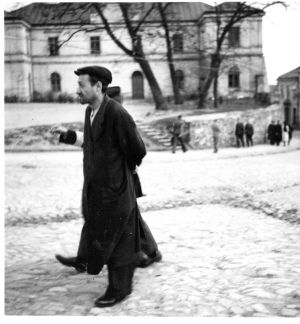Sandomierz

Sandomierz - Jews on a street
Sandomierz is a town in south-eastern Poland on the junction of the Vistula and San Rivers. Approximately 2,500 Jews lived in Sandomierz during the interwar period, representing more than one third of the towns inhabitants. Most earned their living from shop-keeping, as artisans, and commerce, especially in wood, grain and eggs. Sandomierz had a free-loan society, two Jewish banks, traditional Jewish welfare institutions, and a TOZ (Society for the Protection of the Health of the Jewish Population in Poland) clinic. Most of the Jewish community’s boys studied in a traditional Heder, followed by a Yeshiva. The girls attended Polish public schools and were tutored separately in Jewish studies and Hebrew. The town had chapters of the Zionist parties and pioneering training facilities, as well as an active Agudath Israel. Sandomierz also boasted a Yiddish library and a Maccabi sports club.On 12 September 1939, the Germans occupied Sandomierz and deported its entire Jewish population aged twelve to sixty from the town. Several Jews were murdered during this deportation and the Jews were transferred to nearby locations, suffering much abuse in the process, however, on 14 September 1939 they were allowed to return to Sandomierz.
On 20 November 1939, a Judenrat was established, headed by an attorney, Dr. Goldberg. Large fines were exacted, shops were looted by local Poles and many Jewish residents were seized for forced labour. As of December 1939, the Jews were ordered to wear white Star-of-David armbands and the letter J for ‘Jude.’ They were forbidden to circulate on the pavements and in the same month Jews arrived in Sandomierz from Kalisz and Sieradz. In the wake of their severe economic distress, most of the Jews of Sandomierz were compelled to exist on the support provided by the Judenrat. A special employment bureau affiliated with the Judenrat recruited workers, including women, for very harsh forced labour. On 25 November 1941, the Jews were ordered to hand over to the Germans all furs in their possession, but many preferred to hide them or destroy them.

Sandomierz - Hindenburg Kaserne (Tall Trees Archive)
In June 1942, a ghetto was established in Sandomierz, although it was an open ghetto and not sealed, though as usual Jews were not permitted to leave it. In September 1942 hundreds of Jews were marched on foot from the surrounding areas to the ghetto. Scores of Jews were unable to keep up the pace and were murdered along the way. The Sandomierz ghetto was among the last to be liquidated in the Radom District. Commencing on 29 October 1942, a two week ‘Aktion’ took place in the ghetto and more than 3,200 Jews were deported to the Belzec death camp, and its deadly gas chambers. On combing out the ghetto the Germans and Ukrainian forces murdered some 200 people in their hiding places, and they murdered another 78 people on their way to the cattle cars waiting at the railway station.
Scores of Jews remained at the Sandomierz labour camp, including the professional craftsmen, members of the Jewish Order Service, and dozens of Jews the Order Service managed to smuggle into the camp. On 10 November 1942, the Germans re-established a ghetto in Sandomierz, in which they concentrated approximately 8,000 Jews from throughout the district. They lured the Jews with false promises that they would be found work. Following rumors of an impending ‘Aktion,’ some 3,000 Jews fled.
On 10 January 1943 approximately 6,000 Jews were deported from the ghetto to the Treblinka death camp and some 400 youths were transferred to the Skarzysko- Kamienna labour camp, where most perished after a short time. It is known that Underground activities were organised in Sandomierz that strove from the start to establish a base for partisan activities in the surrounding forests, but contacts made with the local cell of the Armia Krajowa (AK – Home Army) ended tragically.
Sources:
The Yad Vashem Encylopiedia of the Ghettos During the Holocaust Volume 1, Yad Vashem, 2009.
Y. Arad, Belzec, Sobibor, Treblinka – The Aktion Reinhard Death Camps, Indiana University Press, Bloomington and Indianapolis 1987
Photographs - Chris Webb Archive, Tall Trees Archive
© Holocaust Historical Society 2018

